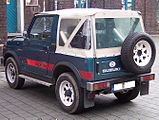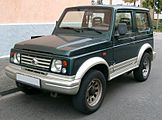Suzuki SJ
| Suzuki | |
|---|---|
|
Suzuki SJ410 (1981-1988)
|
|
| SJ / Samurai | |
| Production period: | 1981-2004 |
| Class : | Off-road vehicle |
| Body versions : | Station wagon , convertible |
| Engines: |
Otto engines : 1.0–1.3 liters (33–51 kW) Diesel engines : 1.9 liters (46–47 kW) |
| Length: | 3429-3439 mm |
| Width: | 1529-1539 mm |
| Height: | 1641-1666 mm |
| Wheelbase : | 2029 mm |
| Empty weight : | approx. 1030-1200 kg |
| Previous model | Suzuki LJ 80 |
| successor | Suzuki Jimny |
The Suzuki SJ models from the Japanese manufacturer Suzuki are a series of light off-road vehicles with ladder frames and rigid axles , which were built from September 1981 to December 2004 with long or short wheelbases and with open and closed bodies as "convertibles" and "van".
All SJ models had rear-wheel drive, a switchable four-wheel drive and a low range ratio and a recirculating ball steering without power assistance . In all open versions, the windshield was foldable.
In Japan, Suzuki has been selling all generations of its light off-road vehicles since 1968 under the name Jimny , while this name was only introduced in Germany with the successor to the SJ series. Outside of Europe, the series was also marketed as the Suzuki Sierra in some export markets. In Switzerland the SJ was offered as the Suzuki 4x4 Strada , in Australia as the Holden Drover .
SJ 410 (1981-1988)
The SJ 410 started in Japan in September 1981 and was presented as the successor to the Suzuki LJ 80 in Germany in spring 1982 with a 1.0-liter engine with 33 kW (45 hp) and a four-speed gearbox .
While the engine with its cast iron -Zylinderblock and Alloy - the cylinder head to the predecessors resembled still strong, the SJ 410 received a newly designed transfer case with U-shaped shift gate and automatic or manual freewheel hub on the front axle.
When it was launched, the SJ 410 was still equipped with drum brakes on all four wheels and had no brake booster . Later versions received disc brakes at the front . The dual-circuit braking system worked separately on the front and rear axles. As with the LJ 80, the handbrake acted on the drive shaft to the rear axle. In addition, there was a parking lock for the rear axle differential already known from the LJ 80 . The tire dimension was 195 × 15.
SJ 413 (1984-1990)
The more powerful SJ 413 followed in autumn 1984 with a 1.3-liter engine with 47 kW (64 hp) and 100 Nm maximum torque. In 1987 a version of this engine followed with an uncontrolled catalytic converter and 44 kW (60 hp). The length was 3,430 mm, the gear ratio of the axle differentials was 3,909.
Distinctive differences to the SJ 410 are the upwardly curved bonnet to accommodate the higher engine and the new radiator grille with transverse plastic ribs.
From the SJ 413, the closed body was optionally also available with a high roof and panoramic windows at the rear, while the versions with long wheelbase were now available with hard or soft top. In Austria, Suzuki also offered a delivery van without rear windows, without rear seats and with a partition grille. The tire size remained the same, the ground clearance under the differential was 225 millimeters, the approach angle 47 ° at the front and 34 ° at the rear.
The newly developed engine with the designation G13A was a much more modern construction made of light metal with an overhead camshaft driven by a toothed belt and weighed only 78 kg. The mixture preparation took over a downdraft - carburetor with accelerator pump and automatic choke , ignition contactless transistor ignition .
Most SJ 413s were sold with five-speed transmissions; only in the first two years of construction was the four-speed gearbox available as an option. There was also a transfer case with changed gear ratios.
The chassis of the SJ 413 received somewhat softer leaf springs and a stabilizer on the front axle. The new drive train made it necessary to change the mountings in the front area of the frame. The versions with a short wheelbase got a diagonally split two-circuit brake system . All versions had a brake booster, the "de Luxe" version had manual freewheel hubs as standard.
Among other things, the vehicle was also produced under license from Santana Motor in Linares , Spain . The vehicles manufactured by Santana are technically not all parts of the same as those from Japan. In addition, Spanish vehicles are said to be more sensitive to rust. You can recognize them by the vehicle identification number beginning with "VSE" , while that of the Japanese vehicles begins with "JSA".
Samurai (1988-2004)
At the end of 1988 the SJ received a facelift and was now also named Suzuki Samurai for export to Germany . It got a 90 millimeter wider track: 60 millimeter wider axles and new wheels with a reduced offset ; plus a more modern dashboard and other small improvements. The translation of the new axle differentials was extended by Suzuki by five percent to 3.727.
The basic shape of the body remained the same, but the exhibited fenders, the headlight surrounds and their frames were now painted in the body color. The slightly widened bumpers were given plastic protectors at the corners, the side indicators were relocated behind the front wheel cutouts and the exterior mirrors were slightly enlarged. As before, two wheelbases and the delivery van remained in the program.
Until the summer of 1990 there was the carburetor engine (G13A) of the SJ 413 with 1315 cm³ and 44 kW (60 PS); in the long wheelbase version without an uncontrolled catalytic converter. In September 1990 Suzuki presented the very similar G13B engine with electronically controlled central injection , slightly reduced displacement to 1,298 cm³ and 51 kW (69 hp) and 103 Nm at 3,500 rpm. This engine, which was later installed in the Suzuki Swift, was equipped with a regulated catalytic converter.
In addition, there were two different diesel engines that Suzuki bought from Renault (1890 cm³, 62 PS (46 kW)) and Peugeot (1905 cm³, 64 PS (47 kW)).
Suzuki tuned the Samurai's chassis even more to driving comfort. The front leaf springs only had three layers of springs, the springs and shock absorbers were retuned and a stiffer stabilizer was installed. This reduced the height by 25 mm, while the new tire size of 205/70 R15 reduced the ground clearance under the front differential to 19.5 cm. The Austrian version was already equipped with different wheel suspensions and coil springs in the last year of sales.
In all versions, the brake system got a brake circuit for the front disc brakes and one for the rear drum brakes. The handbrake acted on the drum brakes on the Samurai so that the parking lock on the rear axle differential could be omitted.
In 1992 there was another facelift, the radiator grille was given three cross struts.
In a further facelift in the summer of 1998, Suzuki relocated the front indicators and parking lights from the bumper to the front mask on the outside next to the main headlights and the radiator grille again received four cross struts. The Samurai was built in this form until the series was discontinued at the end of 2004.
Altitude record
With a modified 1986 SJ, a new world altitude record for cars was set on April 21, 2007. On the slopes of the Ojos del Salado volcano in Chile , the two Chileans Gonzalo Bravo and Eduardo Canales drove up to an altitude of 6688 m .
Maruti Gypsy
In India , the SJ continued to be produced by the Suzuki subsidiary Maruti Suzuki India as Maruti Gypsy . Production has ceased in March 2019. Maruti Suzuki shied away from the development effort for the installation of airbags and ABS.
literature
- Gerstl, T. / Weinbacher, B .: The big Suzuki off-road vehicle book , series LJ80 / SJ410 / SJ413 / Samurai, Munich 1993
Web links
Individual evidence
- ↑ Dos chilenos logran record Guinness de altura en vehículo Spanish ( accessed March 16, 2015)
- ↑ dangerousroads.org: the world's most spectacular roads English (accessed March 16, 2015)
- ↑ marutisuzuki.com: Gypsy English ( accessed May 6, 2015)
- ↑ Confirmed: Maruti Gypsy to be Discontinued by March 2019. In: Maxabout News. November 14, 2018, Retrieved January 1, 2019 (American English).







